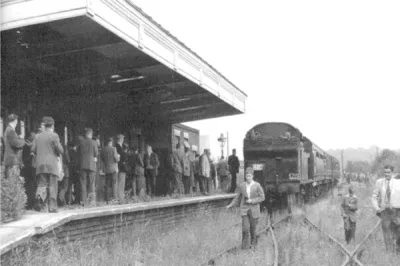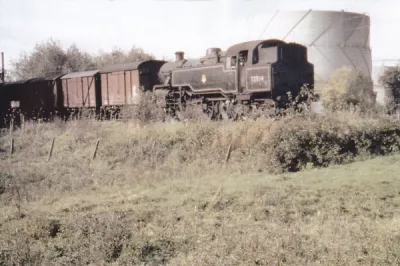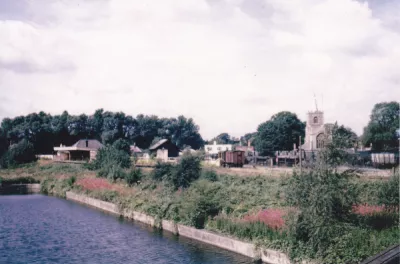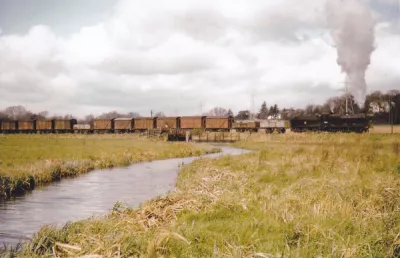Lord Ebury's Railway
Contributed by Chris Hillier

The Watford and Rickmansworth Railway Company (WRR) was a short-lived railway company that ran between Watford and Rickmansworth. It was often referred to as Lord Ebury’s Line after the name of its original chairman, and the line opened in 1862. Lord Ebury’s original proposal, with the support of the London and North Western Railway (LNWR), was to build a line from Watford via Rickmansworth to Uxbridge to join up with the Great Western Railway and provide a link for the two companies, carrying traffic avoiding London.
From 1840s onwards there was a great deal of interest in building railways. The so-called Railway Mania was originally all to do with freight - as the country became industrialised and the population moved from the country to the towns, there was a need to transport goods quickly. Until the 1850s most people were mainly self sufficient, but as people began to move there was a need to transport food and goods to market. Pack horses and carts couldn’t move goods in sufficient quantities and the canals which had developed were too slow for food etc. One of the goods for which this area was famed was water cress, which had to be picked in the early morning and transported to market in London in time for people to eat it for their lunch or tea, and a canal boat would have taken take too long.
In 1861 the population of Rickmansworth was 4873, and in the area were five paper mills, breweries, a silk mill and a tannery. Local carriers were shifting 10,000 tons of goods a year. Passenger traffic to and from Watford was by fly or omnibus, and probably upwards of 100 people were travelling each day to Watford station and on to London. So there was an economic case to build a railway, and a need to have a railway connection to London. Since the London to Birmingham railway had missed Rickmansworth it was thought the best option would be to join this line at Watford.
Lord Ebury and his associates moved quickly: from the initial rumours in March to the bill receiving the royal assent on July 3 1860 was a very short time, but the clauses to allow the Rickmansworth-Uxbridge section to be built was thrown out by the House of Lords. The authorised capital of the Company was £40,000, divided into 4,000 £10 shares, and the board of directors consisted of the Rt. Hon Lord Ebury, Rt. Hon. Reginald Capel (then of Little Cassiobury, Watford) and the Rt. Hon. Robert W. Grosvenor, together with Ralph Etwall, Isaac Warwick - both from Croxley Green - Joseph Gary (Moor Park), Richard Arabin (Rickmansworth) and Herbert Ingram (Loudwater), the founder and owner of the Illustrated London News and the proprietor of Scotsbridge paper mill. The board was therefore composed almost entirely of prominent but local people.
William Rowell, a Rickmansworth solicitor who became the secretary to the Board, had to speak to all the landowners through which the line would pass and whose land would have to be bought - we have glimpses of his travels on these missions. Lord Ebury, who was one on the biggest landowners in the area, was obviously easy to persuade, but those on the route towards Uxbridge were not convinced and so Rowell noted that the Uxbridge part would have to wait. So in July 1860 Lord Ebury was authorised to construct a 4.5 mile single track line between Watford and Rickmansworth, which opened on October 1st 1862, without public ceremony. The weekdays-only service had the following timetable:
Leaving Watford: 8.30am, 9.40am, 3.10pm, 4.00pm, 5.55pm.
Leaving Rickmansworth: 9.15am, 10.30am, 3.30pm, 4.20pm, 6.40pm.
The 1st class single fare was 1s 0d, 2nd class single 0s 8d, 3rd class single 0s 6 1/2d; and 1st class return 1s 6d, 2nd class 1s 0d.
The Rickmansworth farmer John White used the railway to go into Watford market and wider afield routinely, and often recorded in his diaries which train he (and his family) caught.
The Rickmansworth station was located opposite the church to the south of the town, where interchange sidings were provided with the nearby Grand Junction canal.The line had only two other stations, at Watford Junction and Watford High Street, and its depot was situated on Wiggenhall Road in Watford. A further Parliamentary authorisation was obtained a year later to construct an extension from Rickmansworth to Uxbridge to connect with the Great Western Railway’s Uxbridge branch, but this was never built.
Watford High Street station was of technical interest because it had the first signal repeater used in this country, combined with a 'light out' indicator.
The ceremony of turning the first sod at Tolpits Farm was conducted on Thursday 22nd November 1860. The Watford Observer reported that Lord Ebury said that "the day's ceremony was of little importance if only a line from Rickmansworth to Watford was built". His most hearty co-operation would be given to a line which also went to Uxbridge. "If the line to Uxbridge is built the GWR will bring smokeless Welsh coal to the Chess and Colne valleys.” Indeed the boast was that the advent of the railways would half the price of coal in the Watford area - similar statements had been made about the coming of the canal seventy years earlier.
Those with a knowledge of railway history will have noticed a problem in the plan. The lines coming into Uxbridge were Brunel’s broad gauge (7ft between the rails) whereas the London - Watford lines were built to Stephenson’s standard gauge (4ft 8½ins between the rails). The Rickmansworth to Watford line was to be built using standard gauge track, and the LNWR were to erect, operate and maintain all the railway.
At the AGM of the WRR company in September 1862 Lord Ebury reported that "the line was complete, and arrangements perfected for being worked by the LNWR". He also announced that an agreement was under consideration by the GWR "under which that Company would subscribe the capital and work the Uxbridge-Rickmansworth Railway." But from the beginning there were money problems: for example, one way of overcoming the differences in track gauge was to use a third rail, so that trains of either gauge could run on the same track, but this would have added greatly to the cost of the project. Eventually the GWR withdrew its promised subscription of £20,000 which was to have gone towards the cost of the third rail. It is difficult to follow, but it seems that Lord Ebury never expected the line to Watford either to have three rails or be of broad gauge, so he must have envisaged a transhipment depot at Rickmansworth to transfer goods from one railway to another – a very costly process
However, the LNWR were not satisfied that the WRR had been built to standard, and commissioned Mr Cawkwell, a superintendent at Euston, to check it. He instructed one of his engineers, Mr Bruyeres, to walk the length of the line from Watford to Rickmansworth. His report shows that he was not impressed. He was concerned that the railway had not been well built, not laid properly in places and in particular the facilities at Rickmansworth Station were inadequate. He added, “the station at R is not ready and there is not the slightest accommodation for any but passenger traffic --- There is no horse and carriage landing though many families of fortune reside in the neighbourhood - nor is there a goods shed of accommodation for a single wagon of coals.I understand that the line is intended eventually to go on to Ux and R will be an intermediate station. But as an intermediate station it will require reasonable accommodation for the goods traffic and coal.” He suggested that the WRR should provide all this before handing the line over to the LNWR.
Lord Ebury promised that he personally would pay for any faults to be put right.
At the same time the bill to extend the line to Uxbridge was published. It stated that the line from Rickmansworth to Uxbridge was to be broad gauge, so recognising that a change of gauge at Rickmansworth would be needed, resulting in further cost.
Eventually the GWR withdrew its promised £20,000, which would have helped pay not only for the third rail but also a trans-shipment yard – for which the land had already been sold off for a gravel pit! The only line remaining was from Rickmansworth to Watford, which never made any money and was eventually purchased from WRR for the sum of £65,000 and absorbed by the LNWR in June 1881.
In 1862 the initial weekday-only passenger service provided six trains in each direction, and the only intermediate station was a single platform at Watford High Street. By 1887 there were 15 daily services from Rickmansworth to Watford and 16 back again, and two services in each direction were through trains to Euston via Watford Junction. Trains were usually a two-coach train pulled by a 0-6-2 freight tank engine, with a steam rail car sometimes used as an economy.



However, there was quite a bit of goods traffic. Apart from large numbers of hampers of watercress there was a contract with the Bell’s Asbestos works at Harefield which sent asbestos cement sheet by canal using a two-boat shuttle to the canal wharf (‘Batchworth Dock’) near the station, where a steam crane transferred the goods to a waiting goods train often as long as 25 wagons. Engineering drawings for this wharf in the Waterways Archive at Ellesmere Port are dated May 1915.
By the 1920s the passengers became fewer and fewer, the main traffic from Rickmansworth to London having been taken by the Met line which had opened in 1887. In 1907 there were proposals for “New Lines” to provide services to the rapidly growing London suburbs, a line to Croxley Green and a curve at Bushey junction so that trains from Rickmansworth and Croxley could go directly to Euston - the curve which is now above B&Q. in Watford. The Croxley branch opened on 15 June 1912, but shortly afterwards drama came to Croxley on the night of 10 March 1913 when Croxley Station buildings and platform were burnt down by the Suffragettes, and the platforms were replaced by temporary wooden ones which remained until they collapsed in the 1960s.
Neither the Croxley or the Rickmansworth lines were heavily patronised. A special train ran to the station in 1967 for the Loco Club of Great Britain, but that was the end. No trains ran from Rickmansworth direct to London. The Rickmansworth branch closed to passenger traffic in 1952 but freight services continued until 1967. The Croxley branch continued to carry peak-hour services – to both London and Watford – for many more years, but by the 1990s the service had been reduced to a single train from Watford and back at 6 o'clock on weekday mornings, and finally in 1996 the line was severed to make way for a new Ascot Road with the train service replaced by a bus or taxi. The Watford Observer reporting on the closures said, “A sad end to a valiant enterprise – a link with old Rickmansworth and the days of gracious living when Lord and Lady Ebury lived at the Moor Park”.
The track of the line from Rickmansworth now forms the Ebury Way, a pleasant walk or cycle ride from Rickmansworth to Watford, but of Lord Ebury’s Railway nothing now remains.
For more information visit http://www.disused-stations.or...